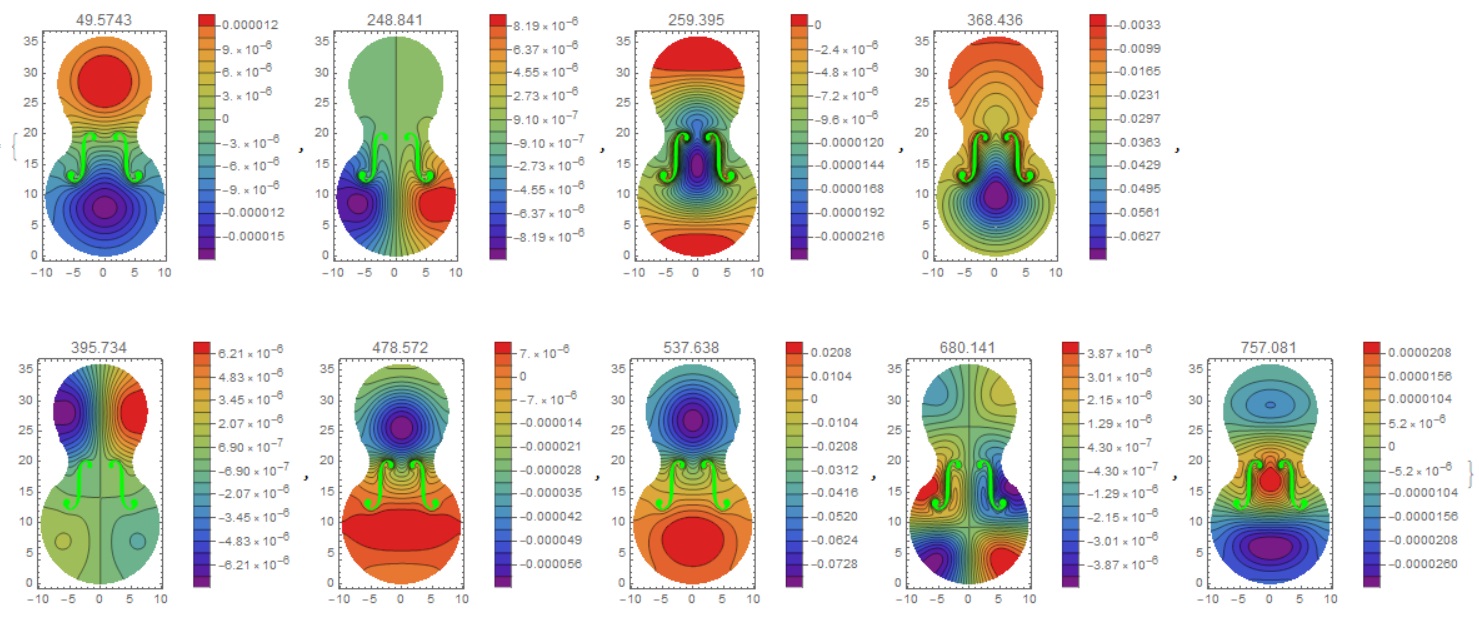Please, look attentively on equations used to calculate bending mode in a wooden plate. It is derived from well known equation commonly used for plates and beams as follows
$$\rho h u_{tt}+D \nabla ^4 u=0$$
The one possible way to compute air modes in the body generated by back plate is DirichletCondition[] for the 3D wave equation. Note that the wave equation turns to the Helmholtz equation since we are search the mode generated by the plate vibration. Code to calculate plate modes (we use dreg from above)
Y = 10.8*10^9; nu = 31/100; rho = 500; h = .003; d =
10^4 Sqrt[
Y h^2/(12 rho (1 - nu^2))]; Ld2 = {Laplacian[-d u[x, y], {x, y}] +
v[x, y], -d Laplacian[v[x, y], {x, y}]};
{vals, funs} =
NDEigensystem[{Ld2, DirichletCondition[u[x, y] == 0, True]}, {u, v},
Element[{x, y}, dreg], 10,
Method -> {"Interpolation" -> {"ExtrapolationHandler" -> \
{Automatic, "WarningMessage" -> False}}}];
Table[DensityPlot[Re[funs[[i, 1]][x, y]], {x, y} \[Element] dreg,
PlotRange -> All, PlotLabel -> vals[[i]]/(2 Pi),
ColorFunction -> "Rainbow", AspectRatio -> Automatic], {i, 2,
Length[vals]}]

Code to compute modes in the body with f-holes (we use mesh1=mesh3d1 and ca from the code above)
Do[solp[i] =
NDSolveValue[{-u[x, y, z] (vals[[i]]/ca)^2 -
Laplacian[u[x, y, z], {x, y, z}] == 0,
DirichletCondition[u[x, y, z] == Re[funs[[i, 1]][x, y]], z == 0],
DirichletCondition[u[x, y, z] == 0,
Element[{x, y}, fh[7, 11.49]] && z == dz]}, u,
Element[{x, y, z}, mesh1]];, {i, 2, Length[vals]}]
Table[Show[
ContourPlot[solp[i][x, y, dz - .1], {x, -10, 10}, {y, 0, 36},
PlotRange -> All, ColorFunction -> "Rainbow",
AspectRatio -> Automatic, PlotLegends -> Automatic,
PlotPoints -> 50, Contours -> 20, PlotLabel -> vals[[i]]/(2 Pi)],
Graphics[{Green,
Polygon[Table[{xy[[i, 1]] - 7, xy[[i, 2]] + 11.49}, {i,
Length[xy]}]],
Polygon[Table[{-xy[[i, 1]] + 7, xy[[i, 2]] + 11.49}, {i,
Length[xy]}]]}]], {i, 2, Length[vals]}]
